评豪斯医生字幕中典故的翻译
- 格式:pdf
- 大小:1.54 MB
- 文档页数:3
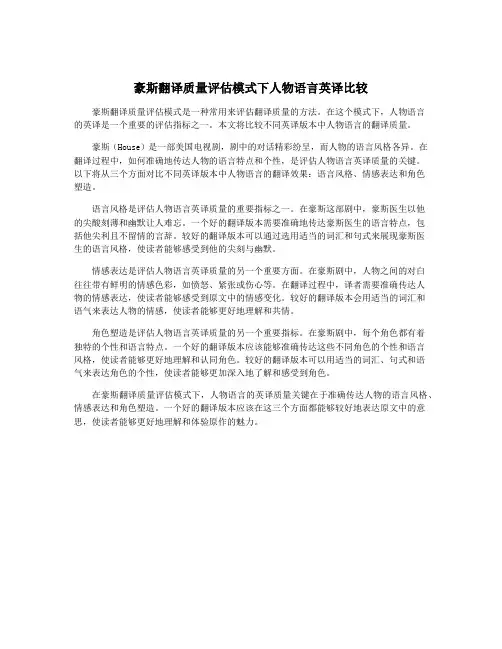
豪斯翻译质量评估模式下人物语言英译比较豪斯翻译质量评估模式是一种常用来评估翻译质量的方法。
在这个模式下,人物语言的英译是一个重要的评估指标之一。
本文将比较不同英译版本中人物语言的翻译质量。
豪斯(House)是一部美国电视剧,剧中的对话精彩纷呈,而人物的语言风格各异。
在翻译过程中,如何准确地传达人物的语言特点和个性,是评估人物语言英译质量的关键。
以下将从三个方面对比不同英译版本中人物语言的翻译效果:语言风格、情感表达和角色塑造。
语言风格是评估人物语言英译质量的重要指标之一。
在豪斯这部剧中,豪斯医生以他的尖酸刻薄和幽默让人难忘。
一个好的翻译版本需要准确地传达豪斯医生的语言特点,包括他尖利且不留情的言辞。
较好的翻译版本可以通过选用适当的词汇和句式来展现豪斯医生的语言风格,使读者能够感受到他的尖刻与幽默。
情感表达是评估人物语言英译质量的另一个重要方面。
在豪斯剧中,人物之间的对白往往带有鲜明的情感色彩,如愤怒、紧张或伤心等。
在翻译过程中,译者需要准确传达人物的情感表达,使读者能够感受到原文中的情感变化。
较好的翻译版本会用适当的词汇和语气来表达人物的情感,使读者能够更好地理解和共情。
角色塑造是评估人物语言英译质量的另一个重要指标。
在豪斯剧中,每个角色都有着独特的个性和语言特点。
一个好的翻译版本应该能够准确传达这些不同角色的个性和语言风格,使读者能够更好地理解和认同角色。
较好的翻译版本可以用适当的词汇、句式和语气来表达角色的个性,使读者能够更加深入地了解和感受到角色。
在豪斯翻译质量评估模式下,人物语言的英译质量关键在于准确传达人物的语言风格、情感表达和角色塑造。
一个好的翻译版本应该在这三个方面都能够较好地表达原文中的意思,使读者能够更好地理解和体验原作的魅力。
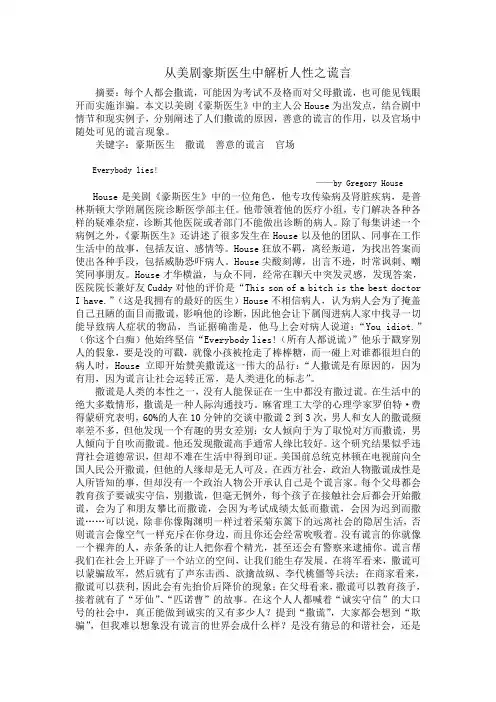
从美剧豪斯医生中解析人性之谎言摘要:每个人都会撒谎,可能因为考试不及格而对父母撒谎,也可能见钱眼开而实施诈骗。
本文以美剧《豪斯医生》中的主人公House为出发点,结合剧中情节和现实例子,分别阐述了人们撒谎的原因,善意的谎言的作用,以及官场中随处可见的谎言现象。
关键字:豪斯医生撒谎善意的谎言官场Everybody lies!——by Gregory House House是美剧《豪斯医生》中的一位角色,他专攻传染病及肾脏疾病,是普林斯顿大学附属医院诊断医学部主任。
他带领着他的医疗小组,专门解决各种各样的疑难杂症,诊断其他医院或者部门不能做出诊断的病人。
除了每集讲述一个病例之外,《豪斯医生》还讲述了很多发生在House以及他的团队、同事在工作生活中的故事,包括友谊、感情等。
House狂放不羁,离经叛道,为找出答案而使出各种手段,包括威胁恐吓病人。
House尖酸刻薄,出言不逊,时常讽刺、嘲笑同事朋友。
House才华横溢,与众不同,经常在聊天中突发灵感,发现答案,医院院长兼好友Cuddy对他的评价是“This son of a bitch is the best doctor I have.”(这是我拥有的最好的医生)House不相信病人,认为病人会为了掩盖自己丑陋的面目而撒谎,影响他的诊断,因此他会让下属闯进病人家中找寻一切能导致病人症状的物品,当证据确凿是,他马上会对病人说道:“You idiot.”(你这个白痴)他始终坚信“Everybody lies!(所有人都说谎)”他乐于戳穿别人的假象,要是没的可戳,就像小孩被抢走了棒棒糖,而一碰上对谁都很坦白的病人时,House立即开始赞美撒谎这一伟大的品行:“人撒谎是有原因的,因为有用,因为谎言让社会运转正常,是人类进化的标志”。
撒谎是人类的本性之一,没有人能保证在一生中都没有撒过谎。
在生活中的绝大多数情形,撒谎是一种人际沟通技巧。
麻省理工大学的心理学家罗伯特·费得蒙研究表明,60%的人在10分钟的交谈中撒谎2到3次,男人和女人的撒谎频率差不多,但他发现一个有趣的男女差别:女人倾向于为了取悦对方而撒谎,男人倾向于自吹而撒谎。

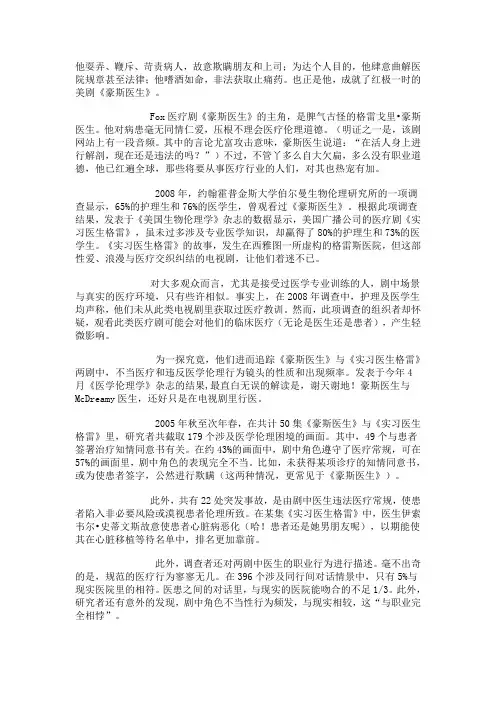
他耍弄、鞭斥、苛责病人,故意欺瞒朋友和上司;为达个人目的,他肆意曲解医院规章甚至法律;他嗜酒如命,非法获取止痛药。
也正是他,成就了红极一时的美剧《豪斯医生》。
Fox医疗剧《豪斯医生》的主角,是脾气古怪的格雷戈里•豪斯医生。
他对病患毫无同情仁爱,压根不理会医疗伦理道德。
(明证之一是,该剧网站上有一段音频。
其中的言论尤富攻击意味,豪斯医生说道:“在活人身上进行解剖,现在还是违法的吗?”)不过,不管丫多么自大欠扁,多么没有职业道德,他已红遍全球,那些将要从事医疗行业的人们,对其也热宠有加。
2008年,约翰霍普金斯大学伯尔曼生物伦理研究所的一项调查显示,65%的护理生和76%的医学生,曾观看过《豪斯医生》。
根据此项调查结果,发表于《美国生物伦理学》杂志的数据显示,美国广播公司的医疗剧《实习医生格雷》,虽未过多涉及专业医学知识,却赢得了80%的护理生和73%的医学生。
《实习医生格雷》的故事,发生在西雅图一所虚构的格雷斯医院,但这部性爱、浪漫与医疗交织纠结的电视剧,让他们着迷不已。
对大多观众而言,尤其是接受过医学专业训练的人,剧中场景与真实的医疗环境,只有些许相似。
事实上,在2008年调查中,护理及医学生均声称,他们未从此类电视剧里获取过医疗教训。
然而,此项调查的组织者却怀疑,观看此类医疗剧可能会对他们的临床医疗(无论是医生还是患者),产生轻微影响。
为一探究竟,他们进而追踪《豪斯医生》与《实习医生格雷》两剧中,不当医疗和违反医学伦理行为镜头的性质和出现频率。
发表于今年4月《医学伦理学》杂志的结果,最直白无误的解读是,谢天谢地!豪斯医生与McDreamy医生,还好只是在电视剧里行医。
2005年秋至次年春,在共计50集《豪斯医生》与《实习医生格雷》里,研究者共截取179个涉及医学伦理困境的画面。
其中,49个与患者签署治疗知情同意书有关。
在约43%的画面中,剧中角色遵守了医疗常规,可在57%的画面里,剧中角色的表现完全不当。
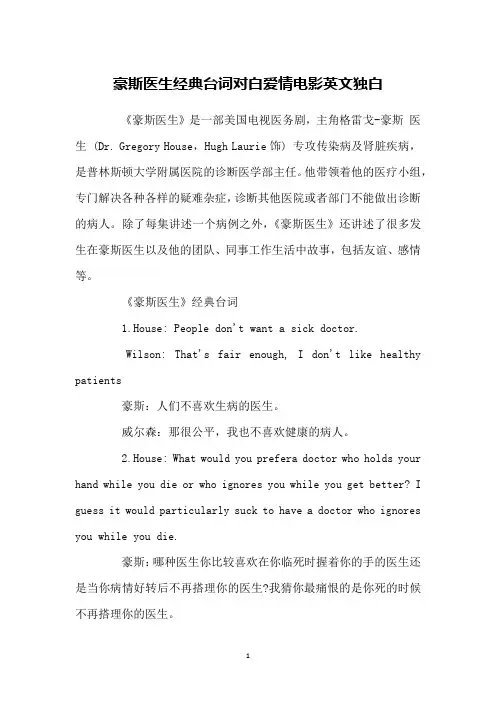
豪斯医生经典台词对白爱情电影英文独白《豪斯医生》是一部美国电视医务剧,主角格雷戈-豪斯医生 (Dr. Gregory House,Hugh Laurie饰) 专攻传染病及肾脏疾病,是普林斯顿大学附属医院的诊断医学部主任。
他带领着他的医疗小组,专门解决各种各样的疑难杂症,诊断其他医院或者部门不能做出诊断的病人。
除了每集讲述一个病例之外,《豪斯医生》还讲述了很多发生在豪斯医生以及他的团队、同事工作生活中故事,包括友谊、感情等。
《豪斯医生》经典台词1.House: People don't want a sick doctor.Wilson: That's fair enough, I don't like healthy patients豪斯:人们不喜欢生病的医生。
威尔森:那很公平,我也不喜欢健康的病人。
2.House: What would you prefera doctor who holds your hand while you die or who ignores you while you get better? I guess it would particularly suck to have a doctor who ignores you while you die.豪斯:哪种医生你比较喜欢在你临死时握着你的手的医生还是当你病情好转后不再搭理你的医生?我猜你最痛恨的是你死的时候不再搭理你的医生。
3.Wilson: If you have the money then why did you need the loan?House: I didn’t. I just wanted to see if you’d give it to me. I’ve been borrowing increasing amounts ever since you lent me $40 a year ago. Ummm, a little experiment to see where you’d draw the line.弗曼:我们做医生不就是为了医治病人吗?豪斯:不,医治疾病才是我们做医生的原因,医治病人则是医生痛苦的根源。
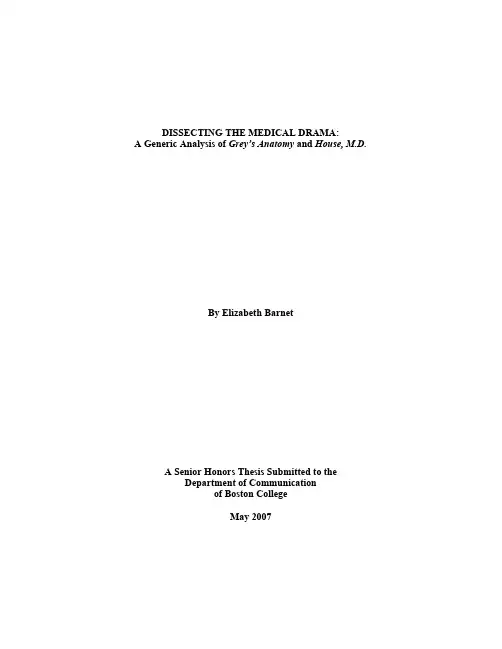
DISSECTING THE MEDICAL DRAMA:A Generic Analysis of Grey’s Anatomy and House, M.D.By Elizabeth BarnetA Senior Honors Thesis Submitted to theDepartment of Communicationof Boston CollegeMay 2007TABLE OF CONTENTS ABSTRACT.................................................................................................... CHAPTER ONE - Examining the Medical Drama: An Introduction (1)CHAPTER TWO - The Facts of the Case: A Review of Literature (5)Setting the Stage for the Medical Drama (5)The Perceived Realism of Television and the Effect on its Viewers (7)Depictions of Medicine on Television (8)CHAPTER THREE - Two Patient Histories: Reconstructing the Contexts of Grey’s Anatomy and House, M.D (12)Grey’s Anatomy: Filling the Prescription for the Medical Drama (12)House, M.D.: “To do no harm” Need Not Apply (18)CHAPTER FOUR - A Successful Procedure: Kathleen Hall Jamieson and Karlyn Kohrs Campbell’s Generic Criticism (22)CHAPTER FIVE - “Cut, Suture, Close”: The Grey’s Anatomy Approach to the Medical Drama (26)Setting (27)Characters (28)Plotlines (32)Romantic Relationships (33)Conflict Between Personal and Professional Life (36)Ethical Dilemmas (41)CHAPTER SIX - Differential Diagnosis: House, M.D. as Medical Drama Anti-Genre (49)Setting (50)Characters (50)Plotlines (53)The Villainous Hero (54)Romantic Relationship (58)Conflict Between Personal and Professional life (65)Ethical Dilemmas (72)CHAPTER SEVEN - Diagnosis and Treatment: The Effects, Implications, and Ethical Considerations of Grey’s Anatomy and House, M.D (84)WORKS CITED (91)ABSTRACTThis thesis examines the medical drama genre of television programming through a close analysis of the popular programs Grey’s Anatomy and House, M.D.. As with any type of genre, the medical drama has developed a successful formula of setting, characters, and plotlines which can be observed in many incarnations of the genre. While it is not necessary for two generic representations to be identical to one another, they will often share a number of characteristics that make the genre successful. Grey’s Anatomy serves as a representative example of the medical drama genre in its most contemporary form; it includes a particular setting, set of characters, and plotlines revolving around romantic relationships, conflict between personal and professional life, and ethical dilemmas faced by its characters.House, M.D. breaks away from using the generic formula of the medical drama and creates a new anti-genre. Although some elements of House, M.D. are similar to those found in traditional medical dramas, these elements are drastically changed. In addition, House, M.D. introduces the innovative element of the villainous hero figure, recognizable in the character of Dr. House. Through a close analysis of selected episodes from both programs, this study will establish both the medical drama genre and the medical drama anti-genre. Further, the investigation will identify implications and effects of the medical drama genre and anti-genre on their audiences.CHAPTER ONEExamining the Medical Drama Genre:An IntroductionTelevision fiction has the potential to amplify and refine the anxieties,hopes and despair of culture and society. We often discover throughtelevision dramas structures of feeling (and anxiety), ways of thinking andmodes of behaviour that we recognise as congruent or adjacent with ourown or with how we image other lives might be. At the same timetelevision, like any art form, develops its own rules, conventions and waysof thinking in relation to its past. This is true for television fiction,particularly that set in the contemporary world, where the requirements ofplausibility are often in tension with the necessity for dramatic invention,and the opportunities and constraints of genre and formula. (Jacobs 149) In Body Trama TV: The New Hospital Dramas, Jason Jacobs’ observations regarding the influence of television fiction on culture and society are neither novel nor surprising. Since its inception, television has undoubtedly changed the way contemporary society views itself as well as how it functions. Though most viewers would maintain that they can recognize television fiction as exactly that, they would be hard pressed to deny the fact that in many ways, dramatized portrayals reflect real life. It is a necessary result, therefore, that real life often reflects dramatized portrayals; the television audience cannot help but internalize what it observes flashing across the screen.While the real world is often unpredictable and constantly transforming, however, the world of fictionalized television is necessarily guided by “rules, conventions, and ways of thinking” (Jacobs 149). Though there is indeed opportunity for creative license, it is the nature of fictionalized television to develop generic elements once a successful formula has been discovered. If a particular type of programming receives popular acclaim, the elements that constitute that type of programming establish a genre. Each drama is not necessarily unique, however; elements of one particular genre are more than likely recognizable in another genre. In addition, many genres are constituted by two or more individual genres.The medical drama genre is one such type of fictionalized television programming that not only contains elements of other genres, but is the fusion of several genres. As was the case for many dramatic genres that came before, the medical drama genre has developed its own blueprint for success. The medical drama genre is worthy of investigation as its impact on contemporary society is undeniable. Although the medical drama can be entertaining and engaging, it is significant because of its potential to inform and persuade its viewers regarding controversial but important topics.The purpose of this investigation is to establish the accepted formula for the medical drama genre and provide analysis of a successful contemporary medical drama, Grey’s Anatomy. However, the author posits that though the genre and the representative program are persuasive, she believes that a new type of medical drama has emerged with equal success. In fact, rather than following the formula of the established medical drama genre, this new genre is actually an anti-genre; in other words, it not only establishes its only generic formula but in many ways defies the standards of the genre that isestablished and accepted. The medical drama House, M.D. will serve as the artifact representative of the medical drama anti-genre.The investigation concludes that the generic formula of the medical drama is characterized by a particular setting, cast of characters, and plotlines. Although different medical dramas might feature variations on this customary formula, there will always be perceivable elements of the genre. The medical drama anti-drama, however, is characterized by an entirely different setting, cast of characters, and plotlines. Although the elements are comparable to a certain extent, the medical drama-anti drama takes the elements of the traditional medical drama and completely transforms them.This study examines three episodes from Grey’s Anatomy and four episodes House, M.D. As both programs are in the process of concluding their third seasons, the episodes under analysis come from seasons one and two. The pilot episode of each program was examined to establish that the elements of the medical drama genre and the anti-genre were present from the very beginning of each program. The remaining episodes were chosen as representative examples of the generic and anti-generic formulas of the medical drama. This analysis reveals that because both Grey’s Anatomy and House, M.D. each closely follow the specific formulas of the medical drama genre and the medical drama anti-genre respectively, virtually any combination of episodes could have been selected for analysis.Chapter Two of this investigation offers a literature review of research already conducted on what constitutes professional television and how the medical drama is an example of it; the perceived reality of television and how it affects viewers; how physicians are portrayed on television and how that affects public perception; and howmedicine is depicted on television. Chapter Three reconstructs the context of the creation and development of Grey’s Anatomy and House, M.D., taking into consideration the creators, the actors, and the achievements of both programs. Chapter Four presents the methodology of generic criticism according to Kathleen Hall Jamieson and Karlyn Kohrs Campbell. Chapter Five applies the generic formula of the medical drama to Grey’s Anatomy and examines three episodes in order to establish the characters, setting, and standard plotlines. Chapter Six establishes the innovation of anti-genre of medical drama as applied to House, M.D.. Chapter Seven discusses the effects and implications of both programs on the medical drama genre and on their viewers, as well as offers a conclusion of the investigation as a whole.CHAPTER TWOThe Facts of the Case:A Review of LiteratureBefore embarking on an analytic investigation of Grey’s Anatomy and House, M.D. as the representative standards of the medical drama genre and its anti-generic counterpart, it is necessary to first examine the research that has already been conducted on several significant topics: what constitutes professional television and how the medical drama is an example of it; the perceived reality of television and how it affects viewers; how physicians are portrayed on television and how that affects public perception; and how medicine is depicted on television.Setting the Stage for the Medical DramaSince its creation in the early 20th century, television has been a technology that never ceases to amaze and fascinate its users. With its widespread popularity, it would only follow suit that a variety of programming genres would be developed to interest television’s variety of users. Today, the various types of television programming is astounding: serious news broadcasting, entertainment news, talk shows, situation comedies, soap operas, educational programs, game shows, and reality shows, just to name a few. With all of the potential genres of programming and the constant need to keep audiences interested, it was practically inevitable that television producers would eventually begin to combine and morph genres.One particularly popular genre of television programming is the drama. Drama is meant to depict characters experiencing events and facing challenges that appear familiarto the audience; the audience of a drama identifies with its characters and the situations in which they find themselves. However realistic they may seem, however, there is a certain element of detachment from the audience. Although the audience can potentially relate to what is occurring in the drama, because it is not actually happening to the audience members, the drama is almost an escapist fantasy. Dramas retain their appeal to audiences because of the combination of the inherent sense of reality and the imaginative fantasy present in them. Although a drama can be performed on a variety of stages for a variety of audiences, the undeniable reach and influence of television makes it the perfect medium through which to portray a variety of dramas.It must be noted, however, that the drama can no longer be considered a pure form of either art or communication. With the development of various types of programming, there are very few uncorrupted genres still in existence. In recent years, one of the most popular forms of “mixed” television genres has been what has been termed the “professional drama”, discussed by Steve Bailey in his article “Professional Television: ‘Three (Super)Texts and a (Super)Genre.” Though it may seem that the professional dramas have only been recently popular, they have in fact been around for years: Ben Casey of the 1960s; M.A.S.H. and Marcus Welby, M.D. of the 1970s; L.A. Law, St. Elsewhere, and Doogie Howser, M.D. of the 1980s; E.R. and Chicago Hope of the 1990s. Somewhere along the growth of the professional drama as a genre came the birth of the medical drama as a specific type of programming. Many of these medical dramas feature similar casts of stock characters, such as the “old doctor” who is the wise advisor of the rash and emotional “young doctor”; the “attractive nurse,” who serves little other purpose than eye candy; and the “hospital administrator,” always more concernedwith the image and success of the hospital rather than the well-being of individual patients (Bailey, 66). Although it varies between particular programs, the characters will usually follow a general outline: patient or patients experience some traumatizing illness, doctors search for the right cure in the meager amount of time allotted to them, all the while having to deal with their personal problems, which, more often than not, will involve various members of the hospital staff. In addition, the setting of these medical dramas is at least in recent times, a large, busy hospital; infrequently does the viewer find the characters in the confines of a doctor’s office or at their homes. These factors are all important when considering the overall effect these programs have on their audiences.The Perceived Realism of Television and Its Effect on ViewersAlthough always relevant when discussing the effects of television on its viewers, it now becomes especially important to discuss the perceived realism of television. As mentioned, whether referring to drama, reality, news, or any other genre of programming, audiences will always have the impetus to identify with what they are watching and apply that to their own lives. In regards to the medical drama, much research has been conducted on the perception of physicians and health care as a result of medicine on television, analyzing depictions that appear on the news, in reality shows, or in the medical drama genre (Pfau and Mullen; Chory-Assad and Tamborini; Harter and Japp). It is sufficient to note that most of this research has concluded that when an audience observes physicians or anything related to medicine or health care, the viewer will inevitably apply these portrayals to their personal lives, and thus, their perceptions will be undeniably altered. Many researchers have acknowledged that although in the past,physicians were always portrayed in the most favorable light, the recent trend has leaned toward a more negative, if not realistic, portrayal of physicians and their personal lives (Bailey; McAllister; Chory-Assad and Tamborini). By “negative,” it is insinuated that while doctors formerly were portrayed as all-knowing, ever-successful, infallible god-like figures, they are now being depicted as more human, capable of fault and mistakes, very much affected by what is going on in their personal lives.Depictions of Medicine on TelevisionA review of contemporary television programs would suggest that there are an abundance of portrayals the medical world on television. From the daily news to soap operas to reality shows, it seems that every channel a viewer turns to, he or she can find a doctor saving the life of a patient, someone receiving unnecessary cosmetic surgery, or the problems of modern healthcare. Considering the widespread portrayal of the medical world in contemporary media, there has already been a great deal of research conducted the portrayals of medicine, doctors, illness, and healthcare on television. The amount and sheer variety of research is astounding; for example, research has examined how audiences interpret portrayals of illness on television, ranging from mental illness on soap operas (Fruth and Padderud), to multiple sclerosis on The West Wing (Zoller and Worrell), to prostate cancer on NYPD BLUE (Arrington and Goodier). Ethical questions have been raised concerning the product placement of medical products (Turner) and the portrayals of live surgery (Loughlin) on television.There has been an unexpectedly extensive amount of research already conducted on topics that are relevant specifically to the medical drama. The more-encompassinggenre of television that the medical drama falls under is often referred to as “professional television,” often associated with the legal and medical professions. In “ ‘Professional television’: three (super) texts and a (super) genre,” Steve Bailey asserts that all professional television shows “share a common narrative focus on the vocational and personal lives of legal and medical professionals, with a particular emphasis on the complex, often ambiguous ethical terrain the central characters must navigate” (45). In referring to professional television as a “(super)genre,” he suggest that it “extends beyond the boundaries of the medium itself to a broader array of discourses…seemingly far-removed from the mere fictional content of dramatic programming” (46). Further, the implications of medically related television as a form of popular discourse have received much attention.In their article “Technology as Representative Anecdote in Popular Discourses of Health Medicine, Lynn M. Harter and Phyllis M. Japp use a Burkean framework to examine “medical dramas as cultural texts to be read for dominant meaning of health and health care” (409). The authors present the dilemma inherent in portraying issues of health and health care within the medical drama; they conclude that audience’s “knowledge about health, illness, prevention, and treatment is constructed from…various, and often contradictory, bits and pieces of information amassed from” cultural artifacts such as television shows (410). The authors analyze the portrayal of western institutional medicine as portrayed in the medical dramas Chicago Hope and ER, and postulate that these programs perpetuate the cultural expectation of utilizing technological medical means over alternative forms of health care.Research has been done specifically on the portrayal of physicians in cinema (Wider), and television, in both fictional and non-fictional programming (Chory-Assad and Tamborini, “Television Doctors: An Analysis of Physicians in Fictional and Non-Fictional Television Programs”); this research has concluded that although physicians were previously depicted in a very positive light (circa the 1930s-1970s), the more recent trend has been to acknowledge their negative characteristics. Further, research has extended to the effects of these portrayals on audience perception of physicians (Chory-Assad and Tamborini, “Television Exposure and the Public’s Perception of Physicians”; Pfau and Mullen, “The Influence of Television on Public Perceptions of Physicians”; Sancho-Aidridge and Gunter, “Effects of a Television Drama Series upon Public Perception about Psychiatrists”). In “Television Exposure and the Public’s Perceptions of Physicians,” Rebecca Chory-Assad and Ron Tamborini expand on their past research that analyzed the contemporary trend of television to portray doctors less positively than they had been portrayed in the past; their study concludes that “the changing patterns of contemporary medical programs, with their increasing emphasis on physicians’ personal behaviors and shortcoming, may negatively influence viewers’ perceptions of doctors” (209).Michael Pfau and Lawrence J. Mullen present similar findings in “The Influence of Television Viewing on Public Perceptions of Physicians.” The authors assert that the “less flattering images [of physicians on television] may exert an influence on the public perceptions of physicians just as the nation begins to focus its attention on the adequacy of the health care system” (442). As Pfau and Mullen’s research was conducted over a decade ago, it is impossible to ignore the fact that audiences of these medical dramashave at least in some way been influenced in terms of how they view doctors. Although a great deal of research has already been conducted on the subject of portrayals of doctors and medicine on television, there are infinitely more ways to examine the phenomena of the medical drama and its influence on its audience.CHAPTER THREETwo Patient Histories:Reconstructing the Contexts ofGrey’s Anatomy and House, M.D.Grey’s Anatomy: Filling the Prescription for the Medical DramaThe most recent incarnation of the medical drama is the critically acclaimed (and controversy driven) Grey’s Anatomy. Premiering on March 25, 2005 on ABC, Grey’s Anatomy has since catapulted to the heights of popularity among viewing audiences and the critical media alike. Creator and executive producer Shonda Rhimes has often commented on how overwhelmed she is by the unanticipated popularity of the program. Originally employed as a movie screenwriter, Rhimes never had an intention of making the move to television writing. However, in an interview with Broadcasting and Cable (5/30/05), Rhimes muses on the inevitability of creating Grey’s Anatomy, commenting that growing up, “[she and her sisters] had always been addicted to surgeries…on Discovery Health” (18). In retrospect, Rhimes asserts that, to many people, “there’s something very sexy about surgery” (18). In regards to the success of Grey’s Anatomy, Rhimes purports that “part of what works so well about Grey’s is the show’s sex appeal”(18). The sex appeal of the show is only enhanced by the sex appeal of the individual cast members, as well as the intense romantic relationships that develop between the characters.However, it must be noted that even the biggest proponents of Grey’s Anatomy would never argue that the show is in any way an innovation or divergence from the typical medical drama. In her interview with Broadcasting and Cable (5/30/05), evenRhimes admits that “Grey’s doesn’t feel particularly special or fresh to [her],” but rather, “it feels like the world” (22). In other words, Rhimes considers the plotlines of Grey’s Anatomy to be realistic and relatable, though admittedly not novel. In a later interview with Broadcasting and Cable (2/27/06), Rhimes discusses why she believes Grey’s has been as successful if not more successfully than previous medical dramas. In the interview, conducted by Broadcasting and Cable’s Mark Robichaux, Robichaux points out that “unlike other medical shows, like ER, there isn’t a big focus on medicine” (5). In response to Robichaux’s inquiry as to why Grey’s Anatomy focuses very little on the actual medicine involved in running a presumably busy and well-respected hospital, Rhimes explains:I like to think that the show is very much a show that’s about therelationships that the doctors are having. I always say that the show is notso much about the patients and the surgery as it is how our doctors feelsabout the patients and the surgeries…. What I love is that we revealdoctors as people, as opposed to heroes…. I think it makes them humanand it makes us feel like we know them and can have a stake in what’shappening with them. (5)Interviews such as these suggest that the creators of the Grey’s Anatomy message make no claims that the show is driven by the medical cases the characters face; more often than not, the patients have very little to do with the plot of the program, though later analysis will demonstrate that this is not always the case. Rhimes subtly suggests, however, that it is the very lack of focus on the medicine that makes the show a success. Previous research has proposed that the majority of television viewing audiences will bemore compelled by a medical drama if the drama focuses on the personal lives of the characters; Grey’s Anatomy wisely has followed the successful formula of the medical dramas that came before. Further, Rhimes follows the more recent trend of depicting doctors as real “people, as opposed to heroes,” perhaps making the characters more compelling and realistic to the audience.Despite the fact that Grey’s Anatomy in many ways follows a pre-existing and highly successful formula, no matter how compelling a story it is, its success depends largely on having a receptive audience. With the sheer number and variety of television programs available, in order for a program to stand out as a success, it must be able to the send the correct message to the correct audience at the correct time. The first episode of Grey’s Anatomy premiered in the popular Sunday night primetime 10:00 p.m. (Eastern Standard Time) following the already widely viewed Desperate Housewives. At its inception, Grey’s Anatomy exploited a readily available audience that would probably be receptive to the program’s content and message. In fact, in its first season Grey’s Anatomy broke records by coming in as the fifth top show of the 2005-2006 season, behind American Idol, CSI, and Desperate Housewives, three programs with practically cult-like followings. With nearly twenty million viewers in this first season, Grey’s Anatomy was no doubt a success.In the seasons to follow, Grey’s Anatomy would only continue to garner a wider audience and to shatter previously set records. According to the media website The Hollywood Reporter, in 2006, Grey’s Anatomy premiered in the number one spot with 25.4 million viewers, ahead of its previous competitors of Desperate Housewives and CSI (</hr/search/article_display.jsp?vnu_content_id=1002576393>). For the third season of Grey’s Anatomy, the producers and ABC made a controversial move that would test the program’s success and staying power. Grey’s Anatomy moved to Thursday evenings at 9:00 p.m. (EST). In addition to Thursday’s being a competitive evening for prime time television, Grey’s Anatomy would now air immediately beforefellow medical drama ER, which airs during the 10:00 p.m. slot on NBC, as well as CBS’s CSI: Crime Scene Investigation. However, the change proved to be successful; according to Nielson ratings, the third season’s premiere of Grey’s Anatomy attracted 25.14 million viewers, surpassing CSI: Crime Scene Investigation with its 22.04 million viewers. In addition, Grey’s Anatomy has been nominated for numerous awards, and has been recognized by such awards as the “Gold Globe Best Television Series – Drama” (2007), in addition to various Emmy Awards, SAG Awards, and People’s Choice Awards.1Despite all of its critical acclaim and devoted audience, like any popular television program, Grey’s Anatomy has endured its own share of criticism. A large amount of the condemnation against the program is from medical groups who claim that the diagnosis, progress, and treatment of illnesses is inaccurately portrayed. In addition,1 Awards received by Grey’s Anatomy’s include: the Producers Guild Award for Best Television Series – Drama (2007); the Golden Globe Award for Best Television Series – Drama (2007) and Best Supporting Actress in a Series, Mini-series, or Motion Picture Made for Television – Sandra Oh (2006); the Screen Actors Guild Award for an Outstanding Performance by a Female Actor in a Drama Series – Sandra Oh (2006), an Outstanding Performance by a Female Actor in a Drama Series – Chandra Wilson (2007), and an Outstanding Performance by an Ensemble Cast in a TV Series – Drama (2007); the TV Land Award for a Future Classic (2006); the NAACP Image Award for Outstanding Drama Series (2006) and Outstanding Actor in a Drama Series – Isaiah Washington (2006); Television Critics Award for Program of the Year (2006); the People’s Choice Award for Favorite TV Drama (2007) and Favorite Male TV Star – Patrick Dempsey (2007); and the Entertainment Weekly award for Entertainers of the Year – Cast of Grey’s Anatomy (2007). In addition, Grey’s Anatomy and its cast members have collectively and individually received over fifty nominations for various other awards including Emmy Awards, Golden Globe Awards, Image Awards, Screen Actors Guild Awards, and a Grammy Award.(</title/tt0413573/awards>)。
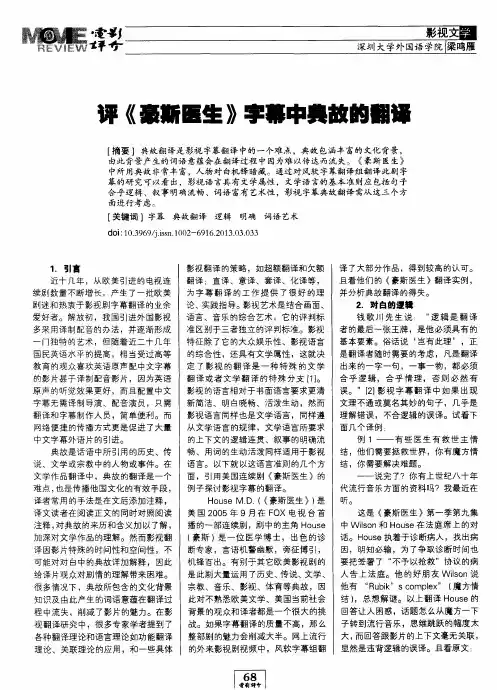
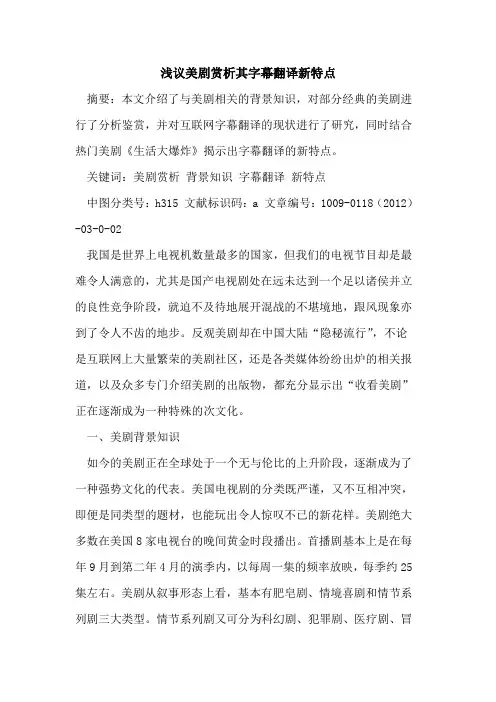
浅议美剧赏析其字幕翻译新特点摘要:本文介绍了与美剧相关的背景知识,对部分经典的美剧进行了分析鉴赏,并对互联网字幕翻译的现状进行了研究,同时结合热门美剧《生活大爆炸》揭示出字幕翻译的新特点。
关键词:美剧赏析背景知识字幕翻译新特点中图分类号:h315 文献标识码:a 文章编号:1009-0118(2012)-03-0-02我国是世界上电视机数量最多的国家,但我们的电视节目却是最难令人满意的,尤其是国产电视剧处在远未达到一个足以诸侯并立的良性竞争阶段,就迫不及待地展开混战的不堪境地,跟风现象亦到了令人不齿的地步。
反观美剧却在中国大陆“隐秘流行”,不论是互联网上大量繁荣的美剧社区,还是各类媒体纷纷出炉的相关报道,以及众多专门介绍美剧的出版物,都充分显示出“收看美剧”正在逐渐成为一种特殊的次文化。
一、美剧背景知识如今的美剧正在全球处于一个无与伦比的上升阶段,逐渐成为了一种强势文化的代表。
美国电视剧的分类既严谨,又不互相冲突,即便是同类型的题材,也能玩出令人惊叹不已的新花样。
美剧绝大多数在美国8家电视台的晚间黄金时段播出。
首播剧基本上是在每年9月到第二年4月的演季内,以每周一集的频率放映,每季约25集左右。
美剧从叙事形态上看,基本有肥皂剧、情境喜剧和情节系列剧三大类型。
情节系列剧又可分为科幻剧、犯罪剧、医疗剧、冒险剧、奇幻剧和战争剧六大类,每一类都有其代表作。
二、经典美剧赏析美剧初入年少记忆。
大陆受众对于美剧的最初印象大多定格在80和90年代引进的一批老美剧。
1980年《大西洋底来的人》和《加里森敢死队》两部美剧成为西方流行文化对中国大陆的首轮冲击,此后,《火星叔叔马丁》、《成长的烦恼》、《神探亨特》,肥皂剧《豪门恩怨》、《侠胆雄狮》等相继登陆中国。
巨大的文化差异、迥异的家庭和教育、性格鲜明的人物以及跌宕起伏的剧情,成为那个时代的文化切片和缩影。
情景喜剧开拓视野。
热播十年的《老友记》可以说是美剧正式在中国受众心中植根的作品。
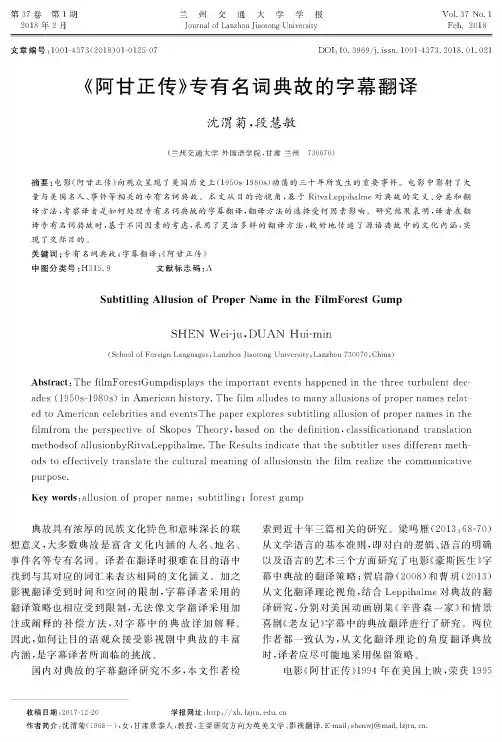
第37卷第1期2018年2月兰州交通大学学报Journal o f Lanzhou Jiaotong UniversityVol.37 No.1Feb.2018文章编号:1001-4373(2018)01-0125-07 DOI:10. 3969/j. issn. 1001-4373. 2018. 01. 021《阿甘正传》专有名词典故的字幕翻译沈渭菊,段慧敏(兰州交通大学外国语学院,甘肃兰州730070)摘要:电影《阿甘正传》向观众呈现了美国历史上(1950s-1980s)动荡的三十年所发生的重要事件。
电影中影射了大 量与美国名人、事件等相关的专有名词典故。
本文从目的论视角,基于RitvaLeppihalme对典故的定义、分类和翻 译方法,考察译者是如何处理专有名词典故的字幕翻译,翻译方法的选择受何因素影响。
研究结果表明,译者在翻 译专有名词典故时,基于不同因素的考虑,采用了灵活多样的翻译方法,较好地传递了源语典故中的文化内涵,实现了交际目的。
关键词:专有名词典故;字幕翻译;阿甘正传》中图分类号:H315. 9 文献标志码:八Subtitling Allusion of P roper N a m e in the FilmForest G u m pSHEN Wei-ju,DUAN Hui-min(School of Foreign Languages, Lanzhou Jiaotong University, Lanzhou 730070 , China)Abstract:T h e filmForestGumpdisplays the important events happened in the three turbulent decades (1950s-1980s)in American history.T h e film alludes to m a n y allusions of proper names related to American celebrities and eventsThe paper explores subtitling allusion of proper names in the iilmfrom the perspective of Skopos T h e o r y,based on the definition,classificationand translation methodsof allusionbyRitvaLeppihalme.T h e Results indicate that the subtitler uses different m e t hods to effectively translate the cultural meaning of al^usionsin the i l m realize the communicative purpose.Key words:allusion of proper n a m e;subtitling;forest g u m p典故具有浓厚的民族文化特色和意味深长的联 想意义,大多数典故是富含文化内涵的人名、地名、事件名等专有名词。
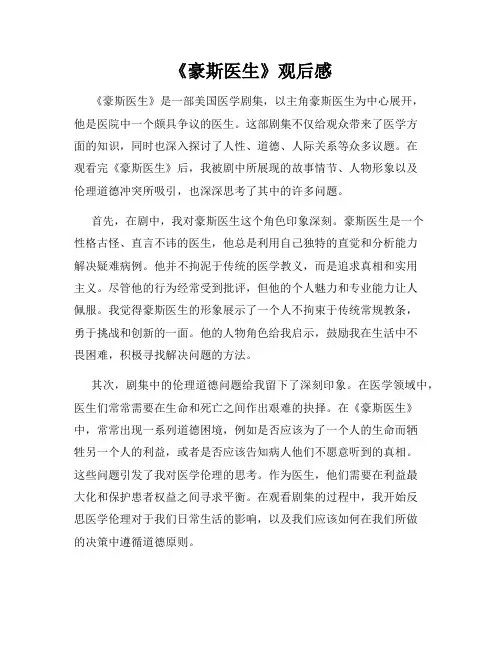
《豪斯医生》观后感《豪斯医生》是一部美国医学剧集,以主角豪斯医生为中心展开,他是医院中一个颇具争议的医生。
这部剧集不仅给观众带来了医学方面的知识,同时也深入探讨了人性、道德、人际关系等众多议题。
在观看完《豪斯医生》后,我被剧中所展现的故事情节、人物形象以及伦理道德冲突所吸引,也深深思考了其中的许多问题。
首先,在剧中,我对豪斯医生这个角色印象深刻。
豪斯医生是一个性格古怪、直言不讳的医生,他总是利用自己独特的直觉和分析能力解决疑难病例。
他并不拘泥于传统的医学教义,而是追求真相和实用主义。
尽管他的行为经常受到批评,但他的个人魅力和专业能力让人佩服。
我觉得豪斯医生的形象展示了一个人不拘束于传统常规教条,勇于挑战和创新的一面。
他的人物角色给我启示,鼓励我在生活中不畏困难,积极寻找解决问题的方法。
其次,剧集中的伦理道德问题给我留下了深刻印象。
在医学领域中,医生们常常需要在生命和死亡之间作出艰难的抉择。
在《豪斯医生》中,常常出现一系列道德困境,例如是否应该为了一个人的生命而牺牲另一个人的利益,或者是否应该告知病人他们不愿意听到的真相。
这些问题引发了我对医学伦理的思考。
作为医生,他们需要在利益最大化和保护患者权益之间寻求平衡。
在观看剧集的过程中,我开始反思医学伦理对于我们日常生活的影响,以及我们应该如何在我们所做的决策中遵循道德原则。
最后,剧集中所揭示的人性缺陷也给我留下了深刻的印象。
医生们往往被视为神圣的人物,但他们也是普通人,有着各种各样的缺点和情感问题。
在《豪斯医生》中,医生们的家庭关系、爱情纠葛以及职业压力等方面都被真实地描绘出来。
这使得他们的人物形象更加立体和真实,让观众可以从中看到医生们背后的挣扎和矛盾。
这让我反思医生也是普通人,他们也会有情绪波动和生活困扰。
对于我们每个人来说,我们应该更加理解和尊重医生的努力和付出,同时也应该更好地理解他们背后的故事。
综上所述,《豪斯医生》这部剧集给我留下了深刻的印象。

《豪斯医生》读后感《豪斯医生》是一部以医疗行业为背景的美剧,讲述了一个天才医生格里高利·豪斯在医院中解决疑难杂症的故事。
这部剧深入探讨了医疗行业的种种问题,引发了观众对医疗伦理、医疗体制等方面的思考。
在剧中,豪斯医生以其独特的思维方式和对病情的敏锐洞察力,成功解决了许多其他医生束手无策的病例。
他不拘一格的治疗方法和对病人的冷漠态度,让观众对医生这个职业有了不同的认识。
豪斯医生的形象既是一个医学天才,又是一个独行侠,他的独特性格和行为方式让人印象深刻。
观看《豪斯医生》让我深刻地反思了医疗行业的种种问题。
在现实生活中,医疗体制的问题、医生的职业道德、病人的权益保护等方面存在着许多隐患。
豪斯医生在剧中频繁违反医疗伦理,但却因为拯救了无数病人而备受尊敬。
这让我思考,医生在面对疑难杂症时,是否应该灵活运用不同的治疗方式,还是要严格遵守医疗规范?另外,豪斯医生在剧中的孤僻与孤独也让我深感触。
作为一个医学天才,豪斯医生在医院中拥有无与伦比的地位,但他的内心却是孤独的。
他在与同事、病人的交往中显得冷漠和疏远,这种孤独感让我不禁为他感到心疼。
这也让我想到,一个人的成功并不是唯一的幸福源泉,内心的孤独和空虚同样重要。
总的来说,观看《豪斯医生》给我留下了深刻的印象。
这部剧不仅仅是一部医疗题材的剧集,更是对医疗行业、医生职业、人性等方面的深刻反思。
通过豪斯医生这个角色,我看到了医生的辛苦与付出,也看到了医疗行业的种种问题。
希望我们能够从中汲取教训,为医疗行业的发展和病人的健康贡献自己的力量。
愿我们都能像豪斯医生一样,成为医疗行业的精英,为社会健康事业做出贡献。
关联理论视角下的影视字幕翻译分析随着多媒体以及全球化进程的逐渐加快,国际性的文化交际已经日渐成为人们生活的一部分并进入人们生活的每一个角落。
不同于传统的文化交际形式,影视文化交流已经成为了目前最占主导地位的一种交际形式。
鉴于当今多元的大量媒体信息是以外国语言的形式出现,而大多数人对外语的掌握毕竟有限,因此,字幕就成为了大众获取信息最重要的手段之一。
电影电视作为娱乐大众的重要方式,近年来的地位不言而喻,因此其字幕的翻译也越来越受到人们的关注。
二十世纪八十年代末,法国认知科学家和英国语言学家D.Sperber和D.Wilson共同提出了关联理论,认为关联是正确理解自然语言的重要手段,这是一个关于语言交际和话语解释的理论,关注的核心问题是交际与认知,其作用是可对人类认知和交际规律做出合理的解释。
文章主要由两个研究问题引导,以期对关联理论视角下的影视字幕翻译有一一个更好的认识。
问题一,关联理论在影视字幕翻译中的可行性及其效果;问题二,如何更好的利用关联理论来发挥影视字幕翻译的作用以及提出相应的翻译策略。
通过对关联理论在影视字幕这一特别的交际形式中的作用的详细阐述,一方面,文章将以具体的形式呈现关联理论由此推动其未来的发展方向;另一方面,对影视字幕翻译的也提供了更多的发展空间,对更进一步的促进跨文化交际也有很大实际意义上的作用。
论文共分为五章:第一章主要对这篇论文做一个大致的介绍,包括作此研究的原因、主要方法、目的以及期望达到的结果。
第二章则是文献综述,主要介绍了包括关联理论的主要相关理论内容、要点、影视字幕的定义、特点,以及在关联理论下的影视字幕翻译有哪些特点和它的可行性。
第三章是论文的主体部分,以《豪斯医生》字幕翻译为例,详细分析了关联理论下的影视字幕翻译的可行性,并提出了相应的可用策略,以及三种翻译方法。
第四章则提出了作为译者,在影视字幕翻译中所扮演的角色,以及他的重要性。
第五章总结了论文并得出结论,归纳了翻译策略。
豪斯医生电影观后感豪斯医生(House, M.D.)是一部以医学为背景的美剧,由David Shore创作,于2004年首播,一直持续到2012年。
该剧以其独特的故事情节、扣人心弦的悬疑和极富个性鲜明的角色形象而广受好评。
作为一名医生和电影爱好者,我对这部电视剧深感兴趣,于是我决定观看并写下观后感。
首先,让我简单介绍一下这部电视剧的背景和主要情节。
故事发生在一个名为普林斯顿-普兰斯堡大学医院的医院内。
主人公是一位天才但又性格古怪的医生——Gregory House。
他是一位顶级的诊断专家,但性格古怪又让人难以相处。
他总是对患者抱有怀疑和挑剔的态度,喜欢用不寻常的方法找出疾病的真正原因。
故事的每一集都是一个新的病例,观众要跟随着House和他的团队一起去解决难题。
通过这部电视剧,观众们能够看到医学界的种种形态。
除了医学知识,豪斯医生也给我们展示了医院内生活的其他方面,如医生之间的相互合作和对伦理和心理的思考。
这些不仅增加了整个剧集的深度,也使得故事更加真实和引人入胜。
在豪斯医生这个角色中,H的特点令人难以忘怀。
他的独特气质和尖锐的智商使他成为剧中最受欢迎的角色之一。
H的角色化身了那种与世无争的特质。
他没有人情味,却总能看穿患者的本质。
尽管他刻薄且常常使用挖苦的语言,但却总是能找到解决办法,治愈病患。
他的迷惑行为有时令人困惑,但也正是这种特质让他成为病人心目中的救世主。
与H一同工作的团队也是该剧的一大亮点。
从詹姆斯·威尔逊到六位年轻医生,每个人都有自己独特的个性和弱点。
他们之间的互动展示了团队合作和医生精神的重要性。
尽管他们有不同的思维方式和个人背景,但他们的目标是相同的:拯救病患的生命。
这种合作也使剧集更加丰富,展现了医学界的多样性。
除了故事情节和角色形象,豪斯医生还以其突出的叙事手法而脱颖而出。
每一集都注重病例的起伏和推理过程,让观众充分参与到解决问题的过程中。
片中通过揭示复杂而棘手的医学疑案,展示了医生们是如何找出问题的根源并解决它们的。
绘本故事谢谢你,豪斯医生教育目标《绘本故事谢谢你,豪斯医生教育目标》豪斯医生是一家以医疗保健为重点的医疗机构,由豪斯医生集团创立于1995年,专注于影响儿童和家庭健康发展的全面医疗服务。
豪斯医生有一个积极倡导儿童健康发展的基本宗旨,即“通过健康教育改善儿童健康,改善全家人的健康状况”。
豪斯医生的教育目标是在护理和健康护理实践中培养儿童对健康的基本学习知识。
例如,豪斯医生鼓励孩子们参与“绘本故事”,讲述那些描绘儿童健康、可持续性发展和角色建设的有趣故事。
该机构通过启发孩子们发展正确的观念,来促进他们的健康成长。
“绘本故事”能够帮助孩子们了解不同的健康故事,让他们意识到健康保持的重要性。
它们还能够通过丰富的绘本形式来向孩子们介绍关于健康的主题,激发他们的好奇心,因此引发孩子们参与健康行为的积极性,从而让他们能够建立一个良好的健康习惯。
此外,豪斯医生还积极推女子健康知识和技能的教育,以进一步提高女童的健康状况,改善女童受教育的环境,激励女童参与更多的学习和工作。
豪斯医生的教育计划着重于提高女童的自信心,为女童提供有关性别歧视和健康的基础知识,并且提供性教育课程,有助于培养女童积极健康的生活方式。
豪斯医生在提高儿童健康素养方面也大有作为。
它们采取了一系列措施,将健康知识纳入学校课程,向孩子们传播健康理念,丰富他们的健康知识,有助于他们在日常生活中应用健康知识,例如从健康的饮食习惯,良好的睡眠习惯,到健康的劳动习惯,增强他们的身体和心理健康。
豪斯医生也通过在社会媒体上开展健康教育工作,传播正确的健康理念,开展健康活动,为家长提供一些专业的建议,在孩子们身边做出正确的健康指导。
通过以上这些措施,豪斯医生有助于影响家庭健康,提升儿童健康水平,提高家长对健康状况的重视度,并且创造健康的家庭环境。
豪斯医生始终坚持“谢谢你”这一核心价值观,让每一位孩子都能够拥有健康的生活,得到应有的尊重。
它们一直关注如何提高儿童的健康水平,并致力于为每一个家庭带来健康,每一个孩子都能够拥有健康的未来。
豪斯医生中的医学伦理与人性探讨概述《豪斯医生》是一部美国剧集,讲述了一位天才但非常古怪和反叛的医生格里高利·豪斯在普林斯顿普腾之平均LINK 掌管下领导团队接诊疑难杂症和解决医学谜题的故事。
这个剧集不仅引人入胜,还渗透了对于医学伦理和人性的深刻探讨。
医学伦理与患者权益在《豪斯医生》中,我们可以看到对于患者权益的重视。
尽管豪斯有时候会采取冷酷无情的态度,但他从未忘记他作为一名医生的职责,总是竭尽全力为患者提供最好的治疗方案。
这就突出了一个重要的伦理问题——如何在困难、矛盾乃至道德上含糊不清的情况下权衡患者利益与个人信仰?知情同意与信息保密在剧中,《豪斯医生》也探讨了医学伦理中的知情同意和信息保密问题。
豪斯经常面对着与患者家属沟通,有时会做出一些决定可能会影响患者生活或隐私的事情。
这引发了关于是否应该无条件遵守隐私权,以及如何平衡治疗需求与患者自主权之间的讨论。
私人生活与职业道德除了专注于医学伦理方面的问题,《豪斯医生》还涉及到医生的私人生活对职业道德的影响。
主角豪斯在剧中是个天才医生,但他却有各种不良嗜好,包括滥用止痛药和荒淫无度等。
这引发了一个值得思考的问题:医生是否应该始终以身作则,并且自己首先保持健康和道德?患者平等与社会公正《豪斯医生》也反映了医学伦理中的一个重要议题——患者平等和社会公正。
在剧集中展示了各种多样化的患者群体,从不同背景、不同文化、不同社会经济地位的人们。
这强调了医学伦理中的公平原则,即每个患者都应该获得公正的待遇和机会。
结论通过观察《豪斯医生》中所涉及到的医學伦理问题,我们可以深入探讨而了解到有关医学伦理与人性之间的复杂关系。
豪斯医生和其他角色在剧中面临许多道德抉择,这向我们提供了一个有意思且引人思考的视角来探索现实世界中的医学伦理问题。
注:本文内容均为作者原创,不代表任何机构或团体立场。
[摘要]典故翻译是影视字幕翻译中的一个难点,典故包涵丰富的文化背景,由此背景产生的词语意蕴会在翻译过程中因为难以传达而流失。
《豪斯医生》中所用典故非常丰富,人物对白机锋暗藏。
通过对风软字幕翻译组翻译此剧字幕的研究可以看出,影视语言具有文学属性,文学语言的基本准则应包括句子合乎逻辑、叙事明确流畅、词语富有艺术性,影视字幕典故翻译需从这三个方面进行考虑。
[关键词]字幕 典故翻译 逻辑 明确 词语艺术1.引言近十几年,从欧美引进的电视连续剧数量不断增长,产生了一批欧美剧迷和热衷于影视剧字幕翻译的业余爱好者。
解放初,我国引进外国影视多采用译制配音的办法,并逐渐形成一门独特的艺术,但随着近二十几年国民英语水平的提高,相当受过高等教育的观众喜欢英语原声配中文字幕的影片甚于译制配音影片,因为英语原声的听觉效果更好,而且配置中文字幕无需译制导演、配音演员,只需翻译和字幕制作人员,简单便利。
而网络便捷的传播方式更是促进了大量中文字幕外语片的引进。
典故是话语中所引用的历史、传说、文学或宗教中的人物或事件。
在文学作品翻译中,典故的翻译是一个难点,也是传播他国文化的有效手段,译者常用的手法是在文后添加注释,译文读者在阅读正文的同时对照阅读注释,对典故的来历和含义加以了解,加深对文学作品的理解。
然而影视翻译因影片特殊的时间性和空间性,不可能对对白中的典故详加解释,因此给译片观众对剧情的理解带来困难。
很多情况下,典故所包含的文化背景知识及由此产生的词语意蕴在翻译过程中流失,削减了影片的魅力。
在影视翻译研究中,很多专家学者提到了各种翻译理论和语言理论如功能翻译理论、关联理论的应用,和一些具体影视翻译的策略,如超额翻译和欠额翻译;直译、意译、套译、化译等,为字幕翻译的工作提供了很好的理论、实践指导。
影视艺术是结合画面、语言、音乐的综合艺术,它的评判标准区别于三者独立的评判标准。
影视特征除了它的大众娱乐性、影视语言的综合性,还具有文学属性,这就决定了影视的翻译是一种特殊的文学翻译或者文学翻译的特殊分支[1]。
影视的语言相对于书面语言要求更清新简洁、明白晓畅、活泼生动,然而影视语言同样也是文学语言,同样遵从文学语言的规律,文学语言所要求的上下文的逻辑连贯、叙事的明确流畅、用词的生动活泼同样适用于影视语言。
以下就以这语言准则的几个方面,引用美国连续剧《豪斯医生》的例子探讨影视字幕的翻译。
House M.D. (《豪斯医生》)是美国2005年9月在FOX电视台首播的一部连续剧,剧中的主角House(豪斯) 是一位医学博士,出色的诊断专家,言语机警幽默,旁征博引,机锋百出。
有别于其它欧美影视剧的是此剧大量运用了历史、传说、文学、宗教、音乐、影视、体育等典故,因此对不熟悉欧美文学、美国当前社会背景的观众和译者都是一个很大的挑战。
如果字幕翻译的质量不高,那么整部剧的魅力会削减大半。
网上流行的外来影视剧视频中,风软字幕组翻译了大部分作品,得到较高的认可。
且看他们的《豪斯医生》翻译实例,并分析典故翻译的得失。
2.对白的逻辑钱歌川先生说:“逻辑是翻译者的最后一张王牌,是他必须具有的基本要素。
俗话说‘岂有此理’,正是翻译者随时需要的考虑,凡是翻译出来的一字一句,一事一物,都必须合乎逻辑,合乎情理,否则必然有误。
”[2]影视字幕翻译中如果出现文理不通或莫名其妙的句子,几乎是理解错误,不合逻辑的误译。
试看下面几个译例:例1 ——有些医生有救世主情结,他们需要拯救世界,你有魔方情结,你需要解决难题。
——说完了?你有上世纪八十年代流行音乐方面的资料吗?我最近在听。
这是《豪斯医生》第一季第九集中Wilson和House在法庭席上的对话。
House执着于诊断病人,找出病因,明知必输,为了争取诊断时间也要把签署了“不予以抢救”协议的病人告上法庭。
他的好朋友Wilson说他有 “Rubik’s complex” (魔方情结),总想解谜。
以上翻译House的回答让人困惑,话题怎么从魔方一下子转到流行音乐,思维跳跃的幅度太大,而回答跟影片的上下文毫无关联,显然是违背逻辑的误译。
且看原文:doi:10.3969/j.issn.1002-6916.2013.03.033评《豪斯医生》字幕中典故的翻译——You know some doctors have the Messiah’s Complex. They need to save the world. You’ve got the Rubik’s Complex. You need to solve the puzzle.——Are you done, or do you have more references to 1980s fads? I’m trying to listen to this.译者显然对 Rubik’s Complex 的背景了解不够,加上后面句子中出现的 “listen”, 想当然地把 “fads” 当成了流行音乐。
“Rubik”是指匈牙利的Ern ő Rubik,1974年他发明了“魔术方块”,即魔方,也称鲁比克方块(Rubik's Cube)。
在80年代魔方游戏风靡一时,相关的玩法指南的书籍也得以出版。
这里豪斯说的 “fads”应该是指玩魔方的风潮,逻辑上才合乎情理,而不是什么流行音乐,更不是最近在听流行音乐。
试比较:——有些医生有救世情结,总想拯救世界,而你有魔方情结,总想解开谜团。
——说完了?还是你有流行于八十年代的魔方的玩法指南?我在听辩论呢。
例2 ——赠给Jimmy Wilson, 年轻的医生。
这句赠言出现在《豪斯医生》第一季第十二集。
病人是棒球队球员,给了Wilson 一张亲笔签名的棒球卡,卡上有上面的赠言。
这一句看起来没什么不妥,细想却让人费解。
Wilson 医生怎么说也不算是年轻的医生了,四十多岁的肿瘤科主任,而且,写上一句“年轻的医生”意义何在?原文如下:——“To Jimmy Wilson, the Cy Young of medicine.”原文中的 “Young”并不是“年轻”的意思,大写字母 “Y”, 而且前面还有缩写 “Cy”,很明显是人名。
查维基百科可以知道,“Cy Young” 是美国二十世纪有名的棒球投手Denton True Cy Young. 昵称“Cy Young”来源于这位棒球手的一次快投把看台的挡板都给破坏了,像是给龙卷风(cyclone)刮过一样,记者报道的时候就送了他这个外号Cy (cyclone), 龙卷风。
在Young 去世后甚至还设立了Cy Young Award 基金,奖励优秀棒球投手。
所以这句可以翻译成:——赠给Jimmy Wilson, 医学界的Cy Young.考虑到中国观众对Cy Young 的不熟悉,可以在字幕中加上“棒球明星”的备注。
可见,文化典故为译者设置了诸多障碍,粗心的翻译容易陷入逻辑的陷进。
为了避免少犯错误,译者应该检查译文是否有文理不通,不合情理的地方,多查阅相关的资料,才能做到不望文生义,正确理解原文,选择正确的词义。
3.语言的明确影视语言不同于传统的文学语言之处在于它的瞬时性,画面和对白或字幕一晃而过,观众不能再像读小说一样重读前文,所以影视语言力求简洁清晰,不含混,不模糊,让听者或读者能迅速准确地领会,收到好的表达效果。
影视语言可以蕴涵深意,引起观众深思、回味,但传达给观众的信息必须是清晰明白的,而不是反复看了几遍还是不知所云。
如影片《开往春天的地铁》中的一句“有些人一辈子都在骗人,而有些人用一辈子去骗一个人。
”意思明快简洁却值得玩味。
在《豪斯医生》的翻译中,风软字幕组的译者在有些地方还是未能做到明确地表达,翻译出的句子让观众感到迷惑,试看几个译例:例1—— 难道那三个急症室的医生,两个神经科医生,和一个放射科医生都没发现么?——树上的鸟也没发现。
在第一季第七集的时候,医生Foreman 和House 争辩病人是否有大脑肿瘤。
第一句是Foreman 所说,他列举的医生数目正好是数列三、二、一,House 反驳他“梨树上的鹧鸪也没发现”。
梨树上的鹧鸪是数数歌《圣诞节的十二天》里重复的一句,其中的一句歌词是: “On the third day of Christmas, my true love sent to me: Three French hens, Two turtle doves, And a partridge in a pear tree.” 这里如果只是译成“树上的鸟也没发现”,不了解这首歌背景的观众会觉得莫名其妙,可以考虑增译的策略。
原文如下:——That three ER doctors, two neurologists, and a radiologist missed?——Partridge in a pear tree missed it too.试改译如下:——难道三个急症室的医生,两个神经科医生,和一个放射科医生都没发现么?——数数歌里梨树上的鹧鸪也没发现。
例2 ——你说过的,如果Keith 的症状是周围环境造成的,那么他一到这里,症状就应该消失。
——如果这里的食物不是放在Riker 厨房的案台下,他也就会好些。
第一季第十一集中,House 断定病人Keith 的症状是家里白蚁咬后的毒素造成,Chase 表示怀疑,第一句为Chase 所说,House 进行了反驳,但翻译让人费解,且看原句:——You said it! If Keith’s symptoms had an environmental cause, they would have disappeared as soon as he got here.——If the food here wasn’t one step below Riker’s Island he would’ve gotten better. He’s lost fourteen pounds.Riker Island 位于美国East River,是纽约市十几所监狱所在地。
原字幕翻译是错误的,House 是在评价医院的伙食比监狱里的还差,造成Keith体重下降。
如果仅仅把Riker’s Island作为地理位置名称来翻译显然是不够的,可以考虑翻译这个词组的含义,让句子的意思更明确,观众才看得明白。
试译如下:——你说过Keith的症状是环境因素引起的,那他到这里后症状就应该消失。
——如果这里的伙食不是比监狱还差的话,他已经好转了。
他轻了14磅了。
4.语言的艺术文学作品和影视作品的语言是一种艺术,读者观众可以透过文字画面感受到其中人物的喜怒哀乐,激起情感上的共鸣,所谓“情欲信,辞欲巧”,就是这个道理。